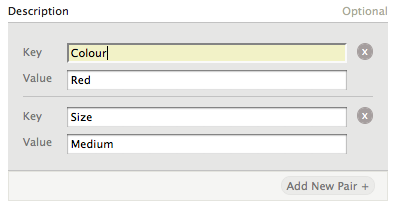1.4.1releasedMeta Keys
The Meta Keys field allows you to add arbitrary pieces of information to entries identified by user generated keys
Clone URLhttps://github.com/brendo/field_metakeys.git
Add as a submodulegit submodule add https://github.com/brendo/field_metakeys.git extensions/field_metakeys --recursive
Compatibility
| 2.x.x | 2.1.x | 2.2.x | 2.3.x | 2.4.x | 2.5.x | 2.6.x | 2.7.0 | 2.7.1 | 2.7.2 | 2.7.3 | 2.7.4 | 2.7.5 | 2.7.6 | 2.7.7 | 2.7.8 | 2.7.9 | 2.7.10 |
|---|---|---|---|---|---|---|---|---|---|---|---|---|---|---|---|---|---|
| No | 0.9.5 | 0.9.5 | 1.0.0 | 1.4.1 | 1.4.1 | 1.4.1 | 1.4.1 | 1.4.1 | 1.4.1 | 1.4.1 | 1.4.1 | 1.4.1 | 1.4.1 | 1.4.1 | 1.4.1 | 1.4.1 | 1.4.1 |
Readme
Meta Keys
The Meta Keys field allows you to add arbitrary pieces of information to entries identified by a user generated key. You can set default keys, and choose different output types by key or named key. It attempts to provide some handy filtering hooks for your datasources as well.
Installation
- Upload the
/field_metakeysfolder to your Symphony/extensionsfolder. - Enable it by selecting the "Field: Meta Keys", choose Enable from the with-selected menu, then click Apply.
- You can now add the "Meta Keys" field to your Sections.
Options
Section
Default Keys
You can set a number of default keys in the Section Editor, these will appear when you first create an entry. If the default keys aren't filled with values,they will be removed with the duplicator upon saving.
If you want to assign a default value to a key, use the :: syntax. eg. Colour::Red, which will fill the Key with 'Colour' and the value with 'Red'.
You can also prefill multiple keys with commas, ie. Colour::Red, Size::Medium. If you need to have a value that includes a comma, escape it, eg. Colour::Red\, Green
Validator
The usual Symphony validation applies to the Values of your Keys.
Required Field
This settings ensures that you at least one completed Pair, the Key and Value, is filled.
Datasources
Named Keys vs. Keys
You can choose between the named keys output, or just a generic key output for your XML. A named key will use the name of the key as the node name, whereas generic will just list each pair under a 'key' node.
Consider the example of Colour: Red:
Normal mode:
xml
<field mode='normal'>
<key handle='colour' name='Colour'>
<value hande='red'>Red</value>
</key>
<field>
Named key mode:
xml
<field mode='named-keys'>
<colour handle='colour' name='Colour'>
<value handle='red'>Red</value>
</colour>
</field>
Filtering
Best efforts have been made for these to support normal Symphony enumerators of +,, and :, but please report any unusual behaviour!
Filter by key (default)
yaml
colour
Normal default filtering without any *: conditions will search on keys. This will return all the entries where a key of colour exists (whether it has a value or not).
Filter by values
yaml
value: red
This will return all entries where one pair exists that has the value of red.
Filter by exact key/value pair
yaml
key-equals: colour=red
This will return all entries where the Colour key equals red. You can chain this as well with key-equals: colour=red, shape=square that will get all entries where the Colour is red and the Shape is square.
Filter by exact key/value pair
yaml
key-contains: colour=red
This will return all entries where the Colour key contains the word red, e. g. it matches red in blue, green, red. You can chain this as well with key-contains: colour=red, shape=square that will get all entries where Colour contains the word red and Shape contains square.
Filter by value range
yaml
key-ranges: 5..10
key-ranges: 5...
key-ranges: ...10
Return all entries where the value in between the given range. An additional third dot allows "more than" (5...) or "less than" (...10) queries.
XMLImporter support
Since the 0.9.5 release, this Field now integrates with XMLImporter. It expects a comma delimited string, eg. red, square. This will populate the first key with red and the second key with square.
If there are default keys, these will be pre-filled first. So if the Default Keys for my Meta Keys field were Colour, Shape, the previous string would result in Colour: red, Shape: square. If the string contained more values than keys, additional keys are named as Key $i, where is $i is the index. So red, square, $10.00 would result in Colour: red, Shape: square, Key 3: $10.00.
Version history
Symphony 2.3.1 to 2.x.x
- Symphony 2.7 compatibility
Symphony 2.3.1 to 2.6.x
- Add new filter option,
key-contains, thanks @nilshoerrmann - Improve range filtering with
key-ranges@nilshoerrmann - Fix XML Importer import functionality, thanks @jurajkapsz
- Allow zero to be a real value, thanks @jurajkapsz
Requires Symphony 2.3.1
- Add German localisation
- Add importable/exportable field functionality
Requires Symphony 2.3.1
- Add filtering support for numeric data, see the README
- Fix potential JS error with the duplicator
Requires Symphony 2.3.1
- Duplicator updates (orderable and sortable), thanks @kanduvisla!
- Implement XMLImporter's updated
prepareImportValuefunction, thanks @nilshoerrmann! - Sanitize keys and allow keys to be assigned a default value, thanks @kanduvisla!
- Add Russian language, thanks @alexbirukov
- Minor cleanups to CSS/README
Requires Symphony 2.3
- Support for Symphony 2.3
- Update to use default Symphony duplicator
- Add
prepareImportValuefunction for the XMLImporter
- Explicitly state UTF-8 for tables (thanks @kanduvisla)
- Fix bug when deleting empty keys (thanks @kanduvisla)
Requires Symphony 2.1.0
- Cleanup of extension for S2.2
- Added Romanian translation (thanks Vlad)
Requires Symphony 2.1.0
- Fix output error when only one key/value pair was added
Requires Symphony 2.1.0
- Few CSS Tweaks to make Meta Keys play better with other fields
- Fix Safari autofocus bug
Requires Symphony 2.1.0
- Initial Public Release
